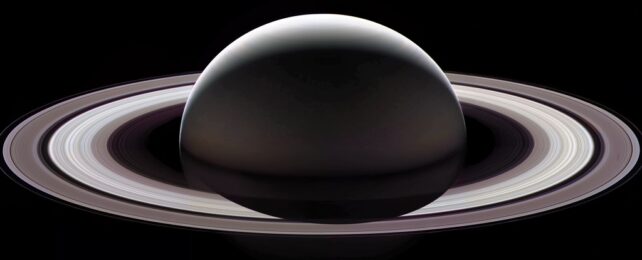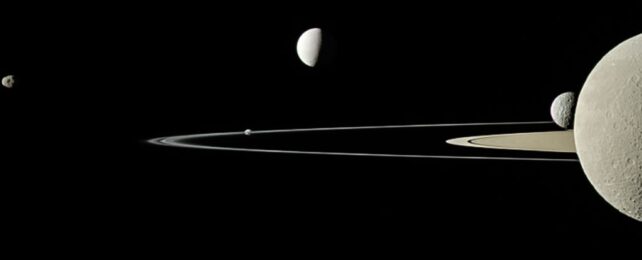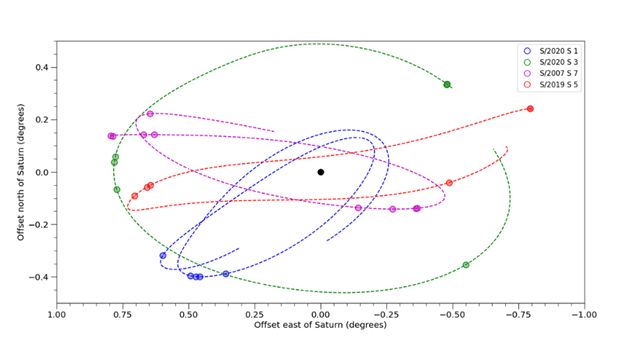
After just a few short months in the lead, Jupiter has once again ceded the title of "most known moons" to Saturn.
The discovery of 62 previously unknown satellites has put the ringed planet firmly back in the lead, with a grand total of 145 officially recognized moons. This means Big Jupe, with its paltry 92 known moons, is going to have to pull out some slick moves if it wants to retake the crown.
More importantly, though, it demonstrates the efficacy of a technique for spotting small moons around the giant planets.
By shifting and stacking images taken of the moons over several years, a team led by astronomer Edward Ashton of the Academia Sinica Institute of Astronomy and Astrophysics in Taiwan was able to find Saturnian moons down to a diameter of just 2.5 kilometers (1.55 miles).

And these newly discovered tiny moonlets are allowing astronomers to piece together Saturn's past.
It's actually fairly challenging locating small moons orbiting Jupiter and Saturn. These two planets are the largest in the Solar System, and they're very bright in the sky, especially from our point of view on Earth, from which they're always in sunlight.
This means they vastly outshine anything around them, making the detection of small, dim objects particularly tricky.
Interestingly enough, the criteria for defining a moon, or natural satellite, are fairly broad. There's no shape or mass or diameter or composition requirement; the object in question just needs to have a stable orbit around another, larger body that isn't a star. So planets, dwarf planets, and even asteroids can all have their own moons.
But it's not sufficient just to spot an object near a planet and declare that you've found a new moon. The object needs to be tracked – ideally for several orbits – so that its path can be analyzed to determine if it's stable. So while shifting and stacking can reveal faint objects, taking many such observations is needed to confirm moon status.
Here's how it works. A set of sequential images is "shifted" at the same rate a moon moves across the sky. Then, these images are stacked, a technique that amplifies signals too faint to be seen in an individual image, and makes them brighter so that scientists can see them.

This shifting and stacking technique had been used to look for moons orbiting Uranus and Neptune; in 2019, Ashton and his colleagues used it to scan the sky around Saturn using the Canada-France-Hawaii Telescope (CFHT), locating what appeared to be previously unknown objects in the space around Saturn.
Between then and 2021, they periodically took observations for three-hour spans, shifting and stacking the resulting images to see if the objects they identified could be moons. They picked out 63 new moons, one of which was announced in 2021. Now, they have painstakingly confirmed the other 62.
"Tracking these moons makes me recall playing the kid's game Dot-to-Dot, because we have to connect the various appearances of these moons in our data with a viable orbit, but with about 100 different games on the same page and you don't know which dot belongs to which puzzle," Ashton says.
All the newly discovered moons belong to the three groups of Saturn's moons classified as "irregular". These – clustered into clumps known as Inuit, Gallic, and Norse moons – orbit the planet on large, elliptical orbits at an inclined angle with respect to the "regular" moons of Saturn.
Most of the new moons fall into the Norse group, which is the most populous and has the greatest orbital distance of the three. It also orbits in the opposite direction to Saturn's rotation.
Astronomers have interpreted these groups as evidence of collisions between moons that took place at some point in Saturn's recent past, leaving behind swarms of smaller moons.
The Norse group, according to analysis, could be what's left after the disruption of a moderately-sized irregular moon. The newly discovered moons are further evidence of this, the researchers say.
"As one pushes to the limit of modern telescopes," says astronomer Brett Gladman of the University of British Columbia in Canada, "we are finding increasing evidence that a moderate-sized moon orbiting backwards around Saturn was blown apart something like 100 million years ago."
Your move, Jupiter.





No comments:
Post a Comment